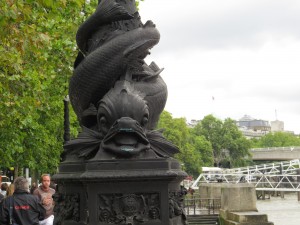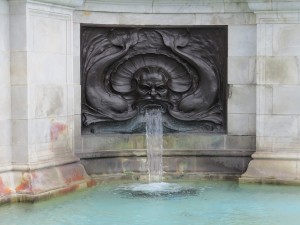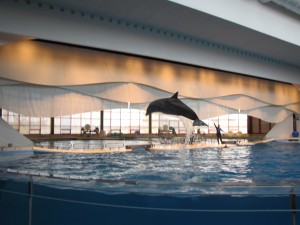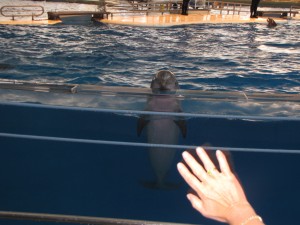As soon as I started the chapter ‘On Monstrous Pictures of Whales,’ I immediately thought of this picture I took in London of a Victorian Era lamppost along the Thames.
Please don’t judge my photography skills based on this particular image, as it’s off-center and tilted. The important point of the picture is that this was what a sculptor in the mid-19th century thought a dolphin looked like. Granted, I have only the word of a certified London tour guide who seemed to enjoy taking the mickey out of the trusting ducklings in his wake.
It did get me thinking, though. To stick with Queen Victoria and dolphins, the Victoria Memorial facing Buckingham Palace features a panel with two more realistic but still imperfect dolphins, circa 1906 (royalparks.org.uk).
Of course, sculpture isn’t the only guilty party, just the only one I happen to have in my personal photo collection. It’s easy for me to criticize artists’ old ideas of dolphins. After all, I’ve seen dolphins! They’ve had their own television shows! They’ve performed for my amusement in aquariums!
Ishmael (or Melville, take your pick) is very critical of those who have attempted to capture the Leviathan in artworks and fallen short of the mark, but how many aquariums existed in the mid-19th century? Okay, the first one opened in the London Zoo in 1853, but it was strictly a fish and invertebrates affair (zsl.org). Nobody had dolphins on show until Marineland in Florida opened in 1938 (marineland.net/anniversary75). Small whales, like belugas, have been displayed in captivity since 1861, when Barnum’s American Museum in New York obtained a pair (lostmuseum.cuny.edu). The New York Tribune 8/9/1861 declared, “A real live whale is as great a curiosity as a live lord or prince, being much more difficult to catch, and far more wonderful in its appearance and habits.”
So it’s fair to say that most artists would not have a firm grasp of what any whale looked like unless they had gone to sea in order to observe the Leviathan directly, or had the opportunity to do by shipping aboard a sperm-whaler. That seems a bit extreme, though it would probably be unwise to argue the point with Melville, who did just that.
It is curious that in all his talk of images of whales, monstrous and acceptable, Ishmael never mentions the painting he saw in New Bedford at the Spouter. After spending so much time contemplating it, he has no judgment to pass on it when the topic of whales in art is discussed at length. Perhaps it’s because you are the one who decided “to find out what that marvellous painting meant” (p. 26). You have to go find that whale and give him a good look to decide on his true nature.
It should also be noted that, due to logistical problems, sperm whales have never been kept or exhibited in captivity (whalefacts.org). Despite nature films and advances in diving technology, very few people have had the opportunity to meet a live sperm whale in the flesh. Maybe Ishmael is right and “there is no earthly way of finding out precisely what the whale really looks like” (p.218).
Works cited
Melville, Herman. Moby-Dick. Norton Critical Edition, 2002.
The Royal Parks (royalparks.org.uk)
Zoological Society of London (zsl.org)
Marineland of Florida (marineland.net)
Barnum’s American Museum – virtual tour (lostmuseum.cuny.edu)
whalefacts.org
Images from the collection of the author – taken in London, 2013; Baltimore 2010.






Erika, your photos are fine and I like the links you made. No one knows all the gifts of the seas and what they in reality look like. Good points.
Hey Erika! I really enjoyed these pictures and I loved how you tied them into the novel. I think that you made some great connections.